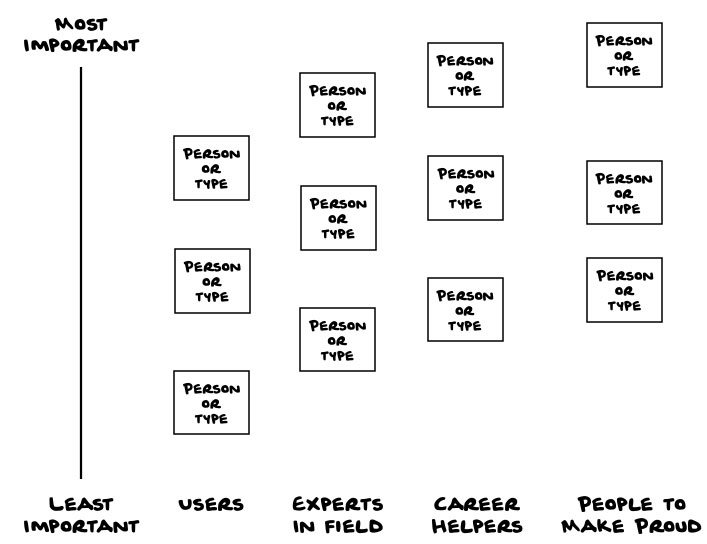Prioritization is deciding.
Today I had my thesis students tackle a hairy question that everybody runs into at one point or another:
Who am I serving?
In a typical project we deal with multiple stakeholder types, user types and collaborator types, all of whom “matter” — all of whom we “serve” with our work, whether that be through our process or our results. All of whom come with their own unique perspective
We started our workshop today by ideating on the following 5 groups of people they will ideally deal with in their thesis work:
- People their products and services serve directly
- People who might help them in their career
- People who are within the industry/market/field(s) that their work touches or impacts
- People who they seek to make proud
- People who they shouldn’t care about the opinions of, but do.
While this list segmentation was architected specifically for use by my masters students, I think the framework actually could apply to many projects and situations. Because prioritizing the (often differentiated) needs of all the people is a job every designer has to do.
How to Prioritize Users and Stakeholders:
Step 1: Generate a pile of post its with people/segments/groups that fall within the five groups above (or modified groups for your context)
Step 2: Discard the group of “people who you shouldn’t care about the opinions of, but do”. You don’t need that kind of baggage. You have your hands full enough. They are out of your head and on a post-it now, leave them there. I suggest ritual burning of post-its for the real toughie distractors. But, be safe kids. And remember that choosing not to serve someone can be a powerful moment, welcome it, it means you are closer to knowing who you are serving even if that’s still hazy.
Step 3: Within each group, rank each post-it in terms of importance relative to the other post-its.
Step 4: Prioritize *across* groups. To start, try to come to one clear most important single person/segment. Once that single one is decided, move on to who is in the number two position. Don’t be surprised if it is very chaotic all the way up to the end. But at the end, no post-its should line up across groups, meaning there are no ties. Break all ties as a rule, otherwise you’ll have to later.
The exercise is usefully visualized as a matrix like the one below:

As you do this exercise, keep asking yourself (aloud with a group would be best) about the priorities you are setting as they relate to the intent of the work
“Does so-n-so’s opinion really matter more than such-n-such’s? Why? What might that mean for the work down the line? Are there changes of priority across all the projects I am undertaking?”
That last question is especially important. I have a student who is working on designing toys that teach children, but a critical fact she is working through is that she isn’t selling to children. In order for her work to be successful, she has to work with the idea that her products might need to serve children above all, but her marketing efforts and educational outreach about the toys she is making have to prioritize the needs of parents and teachers. Because thats her customer. They are how children are going to have access to her work. This is a simple and interesting example of how prioritization can be thoughtfully considered.
But no really, do I have to decide-decide, like really decide? Like now?
I swear to you that making the effort to “prepare to decide” by prioritizing will only help things later on. I can say I have never seen it be hurtful to do this kind of thinking.
I think the main reason to make the investment is that when the moment of decision comes, that tie breaker, whatever it is, you may be hurried or tired or distracted or upset or any other host of intent-amnesia inducing emotions. Making decisions of priority up front can serve as a point of center to come back to when things feel too chaotic and there are just too many ways you could proceed or too many opinions swirling around.
“Which way would so-and-so tell me to go?” is a good question to always have in your back pocket.
Thanks for reading.